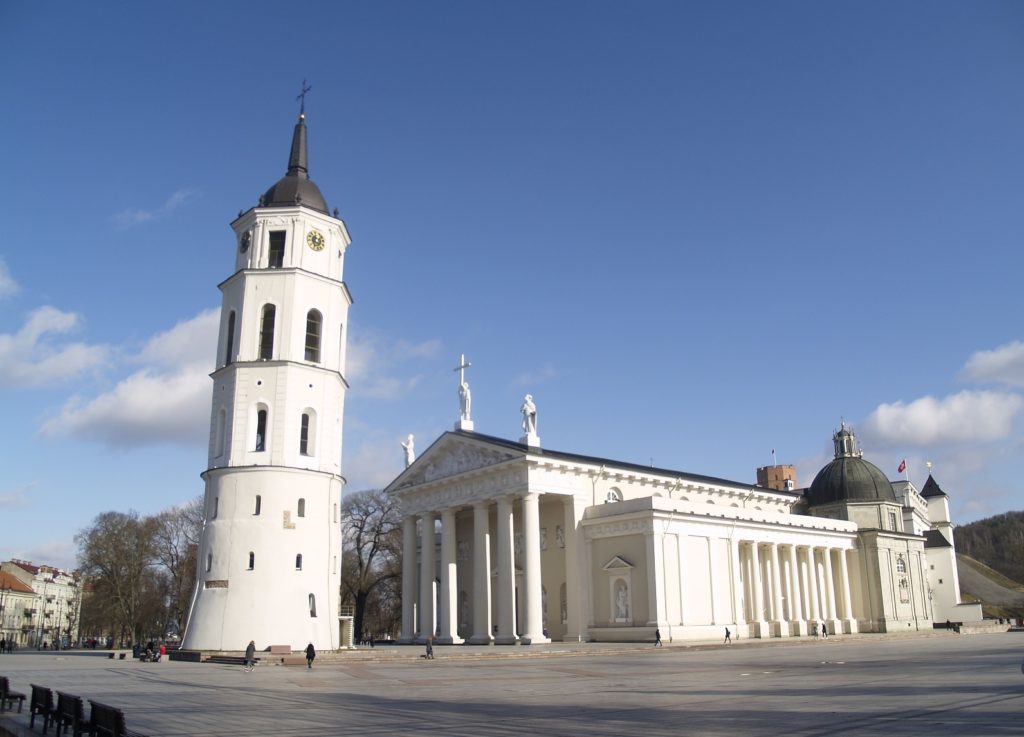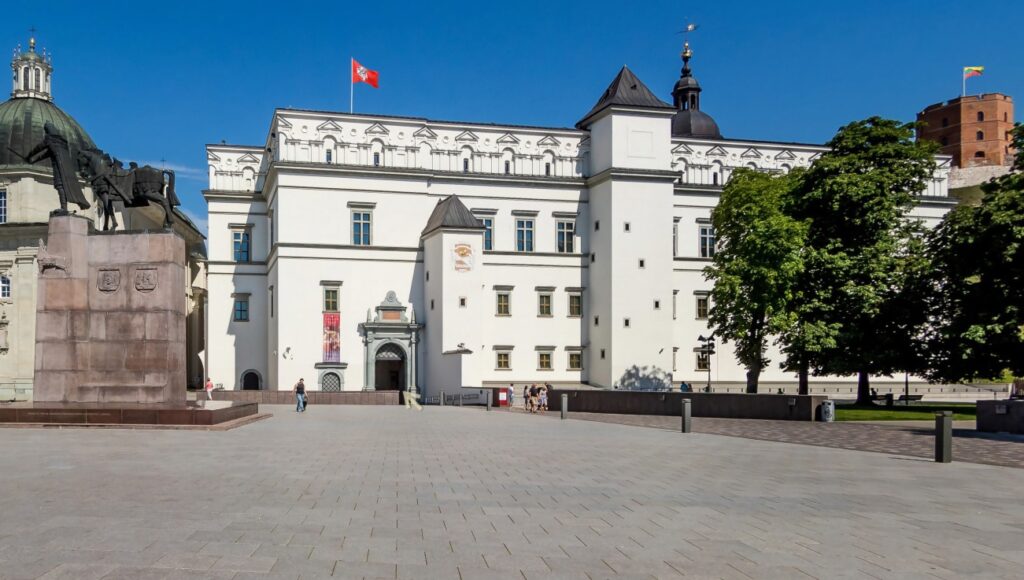Vilnius Cathedral
Introduction

After being baptized in 1251, Grand Duke Mindaugas probably built the first Vilnius Cathedral on this site.
It was a brick building with a massive square tower on the west side. Its remains – foundations and glazed tile floor – were discovered in 1973-76 in the vaults of the present Cathedral.
The building contained elements of a transitional style from Romanesque into Gothic. After Mindaugas’ death (1263) the Vilnius Cathedral might have been turned into a pagan sanctuary again.
After the 1419 fire Vytautas had the cathedral rebuilt as a magnificent Gothic temple. According to a testimony of the traveller Ghillebert de Lannoy, it was reminiscent of the cathedral in Frombork (Frauenburg) in Prussia and on its facade had twin towers of different height.
Vilnius Cathedral Architecture

The side facades hold decorative rococo sculptures from the middle of the 18th century representing seven Grand Dukes on the south one and five Jesuit saints on the north one.
The Cathedral burned several times and was reconstructed and renovated. It acquired certain features of Renaissance, and later-Baroque. Construction works were mainly supervised by Italian architects.
In 1623-36 in the initiative of King Sigismund Vasa, the most beautiful part – the Baroque St.Casimir’s Chapel – was erected.
In September 1769, the south tower of the facade was destroyed by storm, which caused severe damage to the Cathedral. A priest and six ordinands were killed under the ruins. Vilnius Bishop Ignacy Massalski commissioned the best Vilnius architect Laurynas Gucevičius to reconstruct the Cathedral.
More About Vilnius Cathedral

Simple colonnades on the side facades reiterate the monumental columns of the portal.
Above St.Casimir’s Chapel and the sacristy rise symmetrical brass-plated cupolas. The front and side facades are decorated with sculptures. It seems to be the last trace of Vilnius Baroque in the strict 18th century architecture imparting reminiscences of ancient Greece and Rome.
The most beautiful sculptures are placed in niches behind the columns of the central portal. Abraham, moses and the four evangelists with symbolic figures of an angel, a lion, an ox and motifs from New Testament.
The tympanum of the pediment represents Noah’s sacrifice in an impetuous Baroque style. All these picturesque sculptures and relief works noted for the interplay of light and shadows were created by the Italian artist Tommasso Righi in 1785-91.
The church acquired a strictly geometrical square form typical of French Classicism. In pursuit of symmetry, the architect designed a sacristy in front of St.Casimir’s Chapel and crowned it with a cupola. On the west side he built a large portal of six Doric columns with a triangular pediment.
The Cathedral became the most monumental purely Classical building in the entire territory of the Commonwealth.
Interesting
In 1931, the Neris flooded the Cathedral, and cracks appeared in its walls and vaults. In the process of repairing and conserving several crypts have been discovered, among them crypts with the remains of Alexander Jagiellon and two wives of Sigismund August, Elisabeth and Barbora Radvilaitė. A mausoleum was set up to hold these remains.
The Soviet authorities closed the Cathedral in 1950. From 1956 on, the building housed a picture gallery, concerts of organ music used to be held there. It was not until 1989 that the Cathedral was returned to the Catholics and became the major sanctuary again.
INTERIOR of CATHEDRAL BASILICA

The interior of the Cathedral is also Classical and strict.
Four Doric columns of the high altar seem to echo the main facade. In contrast, the chorus and organ face contain abundant Baroque ornaments and sculptures.
The high altar holds the painting “The Death of St. Stanislaus” by Pranciškus Smuglevičius, and the walls of the side naves – 16 paintings by the Italian Constantino Villani. In the south nave they represent scenes from the New Testament. The columns are decorated with figures of apostles painted by Smuglevičius.
The ends of the side naves, on both sides of the high altar, hold two statues by Righi: “Love of Your Neighbour” and “Love of God”.
There are many epitaphs and memorial plaques set up in the 17th-20th century. The most interesting of them seems to be the memorial plaque to Vytautas the Great in the north nave. It is made of black marble with a sandstone frame. The plaque was set up on the initiative of Eustachy Tyszkiewicz who used an inscription from the former monument (1573) for the plaque. However, it does not mark Vytautas’ burial place, which remains undiscovered.





